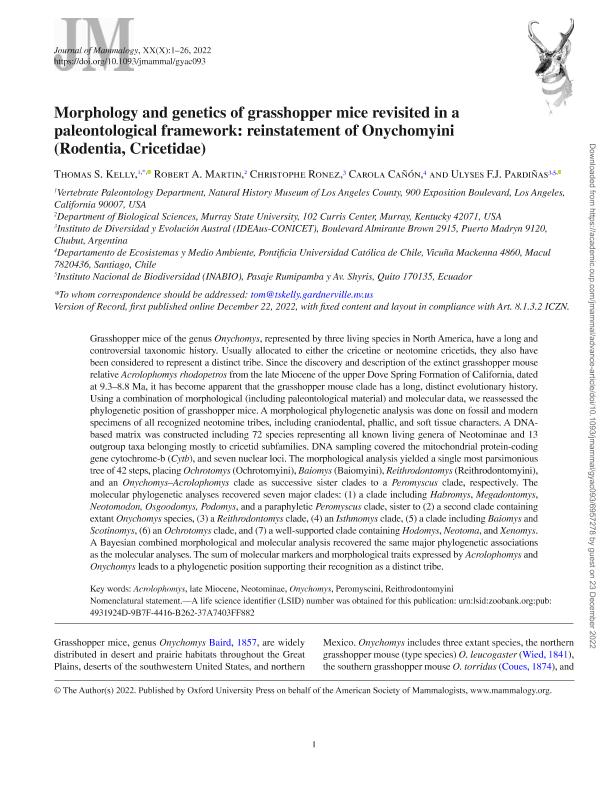Artículo
Morphology and genetics of grasshopper mice revisited in a paleontological framework: reinstatement of Onychomyini (Rodentia, Cricetidae)
Kelly, Thomas S.; Martin, Robert A.; Ronez, Christophe ; Cañón, Carola; Pardiñas, Ulises Francisco J.
; Cañón, Carola; Pardiñas, Ulises Francisco J.
 ; Cañón, Carola; Pardiñas, Ulises Francisco J.
; Cañón, Carola; Pardiñas, Ulises Francisco J.
Fecha de publicación:
02/2023
Editorial:
Oxford University Press
Revista:
Journal of Mammalogy
ISSN:
0022-2372
Idioma:
Inglés
Tipo de recurso:
Artículo publicado
Clasificación temática:
Resumen
Grasshopper mice of the genus Onychomys, represented by three living species in North America, have a long and controversial taxonomic history. Usually allocated to either the cricetine or neotomine cricetids, they also have been considered to represent a distinct tribe. Since the discovery and description of the extinct grasshopper mouse relative Acrolophomys rhodopetros from the late Miocene of the upper Dove Spring Formation of California, dated at 9.3?8.8 Ma, it has become apparent that the grasshopper mouse clade has a long, distinct evolutionary history. Using a combination of morphological (including paleontological material) and molecular data, we reassessed the phylogenetic position of grasshopper mice. A morphological phylogenetic analysis was done on fossil and modern specimens of all recognized neotomine tribes, including craniodental, phallic, and soft tissue characters. A DNAbased matrix was constructed including 72 species representing all known living genera of Neotominae and 13 outgroup taxa belonging mostly to cricetid subfamilies. DNA sampling covered the mitochondrial protein-coding gene cytochrome-b (Cytb), and seven nuclear loci. The morphological analysis yielded a single most parsimonious tree of 42 steps, placing Ochrotomys (Ochrotomyini), Baiomys (Baiomyini), Reithrodontomys (Reithrodontomyini), and an Onychomys?Acrolophomys clade as successive sister clades to a Peromyscus clade, respectively. The molecular phylogenetic analyses recovered seven major clades: (1) a clade including Habromys, Megadontomys, Neotomodon, Osgoodomys, Podomys, and a paraphyletic Peromyscus clade, sister to (2) a second clade containing extant Onychomys species, (3) a Reithrodontomys clade, (4) an Isthmomys clade, (5) a clade including Baiomys and Scotinomys, (6) an Ochrotomys clade, and (7) a well-supported clade containing Hodomys, Neotoma, and Xenomys. A Bayesian combined morphological and molecular analysis recovered the same major phylogenetic associations as the molecular analyses. The sum of molecular markers and morphological traits expressed by Acrolophomys and Onychomys leads to a phylogenetic position supporting their recognition as a distinct tribe.
Palabras clave:
Acrolophomys
,
late Miocene
,
Neotominae
,
Onychomys
,
Peromyscyini
,
Reithrodontomyini
Archivos asociados
Licencia
Identificadores
Colecciones
Articulos(IDEAUS)
Articulos de INSTITUTO DE DIVERSIDAD Y EVOLUCION AUSTRAL
Articulos de INSTITUTO DE DIVERSIDAD Y EVOLUCION AUSTRAL
Citación
Kelly, Thomas S.; Martin, Robert A.; Ronez, Christophe; Cañón, Carola; Pardiñas, Ulises Francisco J.; Morphology and genetics of grasshopper mice revisited in a paleontological framework: reinstatement of Onychomyini (Rodentia, Cricetidae); Oxford University Press; Journal of Mammalogy; 104; 1; 2-2023; 3-28
Compartir
Altmétricas



